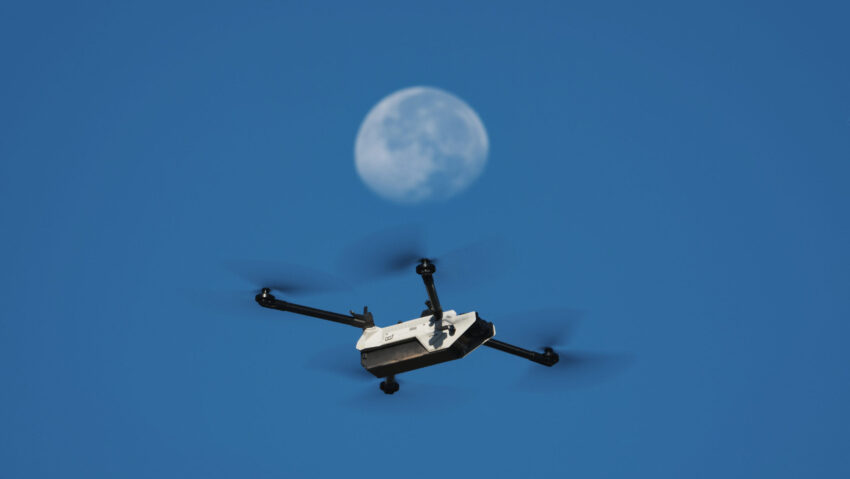Anduril’s new Bolt quadcopter. (Anduril photo)
WASHINGTON — The Defense Innovation Unit will hand over the reins to its Blue UAS List to the Defense Contract Management Agency by Jan. 1 of next year, but the tech-outreach organization still expects to play a role in engaging with vendors and continuously updating the list.
The move was laid out as part of Defense Secretary Pete Hegseth’s ‘Unleashing US Military Drone Dominance’ memo, released late Thursday. The Blue List program creates a directory of Pentagon-approved commercial systems that are fully free of Chinese parts.
“The Blue List will become a trust-but-verify system, managed by the DCMA, which will use sampling to ensure DoD vendors meet statutory requirements,” per the memo. “The DCMA will be properly resourced to accomplish this mission.”
However, a DIU spokesperson noted in a statement released separate to the memo that “DIU will continue to update the related checklists, which will be used by approved third-party and other assessors and across DoD’s innovation ecosystem, to ensure the newest industry technologies are available to the warfighter and that those standards are being met.”
“The actions announced [in the memo] are a critical next step in meeting the Secretary’s intent for scaling the best technology to the warfighter, fast,” the DIU spokesperson added.
The DIU spokesperson also clarified that the DIU will still be responsible, in partnership with DCMA, for keeping the second-tiered Blue “Cleared List” up-to-date — the list that includes manufacturers that were approved by the third-party vendors and drones that have gone through compliance reviews by the Association for Uncrewed Vehicle Systems International (AUVSI) trade group.
The DIU will also work with the services, Special Operations Command and the DCMA to facilitate the top-tiered “Select List,” which includes drones that have been previously sponsored by a DoD entity or been selected through a DoD competition outside of the DIU. Manufacturers on this list include companies Anduril, Skydio, Teal and more.
Apart from the Blue List getting a change in command, the list will now also get some upgrades such as being searchable using artificial intelligence tools and becoming a “trust-but-verify” platform, also known as being zero trust being compliant, Hegseth’s memo read.
Michael Robbins, CEO of AUVSI, noted that DCMA has more funding and more people than DIU, so it is better positioned to take on the responsibility of the Blue List.
“More capacity is good,” Robbins said. “[DIU has] always been very limited in their staffing capacity for Blue List, I guess, from a budget perspective. They’ve had a very small team dedicated to this program. Congress has never allocated funding specifically to Blue List, it has always sort of been an unfunded mandate for DIU. So, if more resources are added to this, to the program, then certainly that’s a good thing.”
But he expressed some skepticism about the memo’s overall pledge to dramatically increase the supply of drones to the military, noting that at the end of the day the DoD’s capability to buy drones, especially ones that are consistent with supply chain standards, comes down to the budget.
“I’m aligned with DIU, and thinking that the involvement of DCMA is going to be a positive to the Blue UAS List,” he added. “But I fall back to that in and of itself, this will do nothing to help speed the acquisition of drones if the funding isn’t there and if those who are actually doing this don’t get out of their own way.”
Robbins acknowledged that AUVSI is “excited about” the money in the 2026 defense budget allocated to small UAS — totaled at $726 million, according to AUVSI, for “small UAS Intelligence Surveillance Reconnaissance” systems. However, he expressed that the money may not be enough, given the fact that AUVSI determined the DoD only bought 4,000 drones last year, which he called a “stunningly low number.”
He noted that this is a stark contrast compared with AUVSI’s findings that Ukraine bought an estimated two million units domestically last year, with another 725,000 commercial drones from non domestic sources.
But he did acknowledge that Ukraine’s circumstances are different, as they lack other, more advanced weapons systems that the US has, coupled with the notion that Ukraine doesn’t have the option to only buy supply-chain-secure parts due to the nature of its ongoing war with Russia.
Click this link for the original source of this article.
Author: Carley Welch
This content is courtesy of, and owned and copyrighted by, https://breakingdefense.com and its author. This content is made available by use of the public RSS feed offered by the host site and is used for educational purposes only. If you are the author or represent the host site and would like this content removed now and in the future, please contact USSANews.com using the email address in the Contact page found in the website menu.








